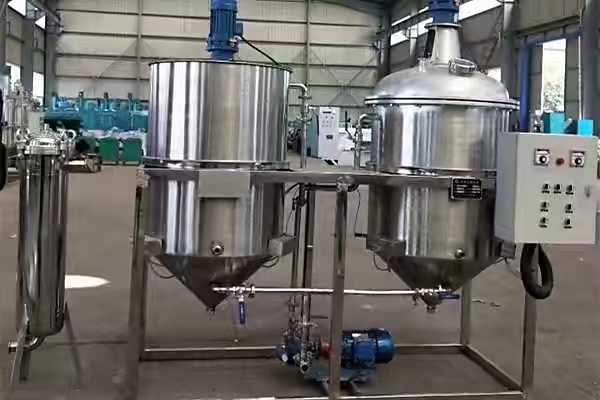Small refining oil equipment is the equipment for removing impurities from crude oil to obtain edible healthy (national safety standard) oil; The work flow mainly includes: crude oil - degumming (water washing) - deacidification (alkali refining) - decolorization (clay adsorption) - dehydration (heating and drying) - product oil. Some oil products may need to add other processes, such as winterization dewaxing; The oil treated by the refiner has transparent color, no precipitation after long-term storage, no foam and oil smoke after cooking, and meets the national edible oil standard. It can be directly filled and sold. It is suitable for processing with supplied materials and small oil processing plants.

1. hydration degumming is a degumming method that uses the hydrophilicity of colloidal impurities such as phospholipids to add a certain amount of water or electrolyte dilute solution to the crude oil while stirring, so as to make the colloidal impurities in the crude oil absorb water, swell, agglomerate and separate. In the process of hydration degumming, in addition to the binding of protein, mucus and trace metal ions with phospholipids, phospholipids are the main substances that can coagulate and precipitate.
2. alkali refining deacidification. All kinds of unrefined crude oil contain a certain amount of free fatty acids. The process of removing free fatty acids from oil is called deacidification. The deacidification methods include alkali refining, distillation, solvent extraction and esterification. Alkaline refining and steam distillation (physical refining) are most widely used in industrial production
3. adsorption decolorization, oil adsorption decolorization, refers to the use of some substances (such as bleaching clay, activated clay, activated carbon, etc.) It has a strong selective adsorption on the pigment, adsorbs the pigment and other impurities in the oil under certain conditions, so as to achieve the purpose of decolorization. After the oil is treated with adsorbent, it can not only improve the color of the oil and remove colloid, but also effectively remove some trace metal ions and substances that can cause poisoning of hydrogenation catalyst, thus providing good conditions for further refining (hydrogenation and deodorization) of the oil.
4. high temperature deodorization is a process that uses the difference in volatilization of odorous substances in oil and triglyceride to remove odorous substances by steam distillation under high temperature and vacuum. The principle of steam distillation deodorization (also known as stripping method) is that the steam passes through the oil containing odor components, the steam liquid surface contacts, the steam is saturated by volatile odor components, and escapes according to its partial pressure ratio, so as to achieve the purpose of removing odor components.

 WeChat / WhatsApp
WeChat / WhatsApp
 Online messageIf you have any questions, please leave a message here to tell us, we will contact you in time!
Online messageIf you have any questions, please leave a message here to tell us, we will contact you in time! Products
Products









 Online service
Online service Telephone
Telephone Message
Message